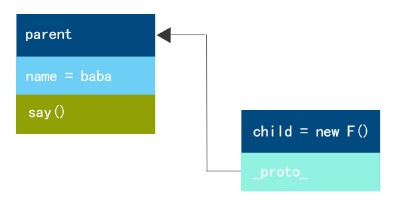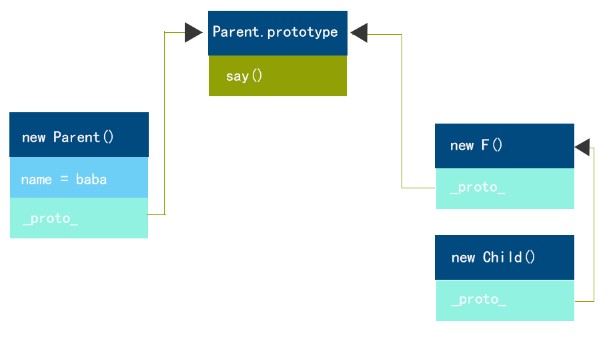 Web Front-end
Web Front-end
 JS Tutorial
JS Tutorial
 JS Inheritance--Prototype Chain Inheritance and Class Inheritance_Basic Knowledge
JS Inheritance--Prototype Chain Inheritance and Class Inheritance_Basic Knowledge
JS Inheritance--Prototype Chain Inheritance and Class Inheritance_Basic Knowledge
What is inheritance? Answer: The process of others giving it to you for free is called inheritance.
Why use inheritance? Answer: Just pick it up ready-made.
Well, since everyone wants to pick up what’s already available, we need to learn how to inherit it!
Before understanding, you need to understand concepts such as Constructor, Object, Prototype Chain...
Two inheritance methods commonly used in JS:
- Prototype chain inheritance (inheritance between objects) class inheritance (inheritance between constructors)
Prototype Chain Inheritance:
//Object to be inherited
var parent= {
name : "baba"
say : function(){
alert("I am baba");
}
}
//New object
var child = proInherit(parent);
//Test
alert(child.name); //"baba"
child.say(); //"I am baba"
Use the proInherit (obj) method and pass in the object to realize the inheritance of the object's attributes and methods. This method is not a built-in method, so you have to define it yourself. It is very simple:
function proInherit(obj){
function F () {}
F.prototype = obj ;
return new F();
}
Where F() is a temporary empty constructor, and then the prototype of F() is set as the parent object, but at the same time it has all the functions of its parent object by benefiting from the _proto_ link.
Chain diagram:

Class inheritance:
//Parent class constructor
function Parent( ) {
this.name = "baba";
}
//Parent class prototype method
Parent.prototype.getName = function () {
return this.name;
}
//Subclass constructor
function Child() {
this.name = "cc";
}
//Class inheritance
classInherit(Parent, Child);
//Instance
var child = new Child();
alert(child.getName()) //“baba”
Let’s take a look at the key methods of inheritance: classInherit(Parent,Child)
var classInherit = (function () {
var F = function () { }
return function (P, C) {
F.prototype = P.prototype;
C.prototype = new F();
C.prototype.constructor = C;
}
}());
Analyze this method:
- First create an empty constructor F(), and use the _proto_ attribute of its instance to build the prototype chain of the parent class and the subclass. It functions as a proxy to prevent C.prototype = P.prototype, which will modify the properties or methods together with the parent class after the subclass is instantiated. The overall use of instant functions and storage of F() in closures prevents the creation of a large number of empty constructors during multiple inheritances, thereby reducing memory consumption. The last line means that due to the prototype chain, the constructor of the instance object of C will point to P, so it is reset.
Chain diagram:
 Although this method inherits the prototype method during the instance, the attributes of the parent class cannot be inherited. The following is a
Although this method inherits the prototype method during the instance, the attributes of the parent class cannot be inherited. The following is a
, which is a supplement to class inheritance.
Copy inheritance:
//Copy inheritance
function copyInherit(p, c) {
var i,
toStr = Object.prototype.toString,
astr = "[object Array]";
c = c || {};
for (i in p) {
if (p.hasOwnProperty(i)) {
if (typeof p[i] === "object" ) {
c[i] = toStr.call(p[i]) == astr ? [] : {};
c[i] = copy(p[i], c[i]);
}
else {
c[i] = p[i];
}
}
}
return c;
}
//Rewrite Parent
function Parent() {
this.name = "pp";
this.obj= {a:1,b:2};
this.arr = [1, 2]
}
//Instance
var child = new Child();
var parent = new Parent();
copyInherit(parent, child);
alert(child.name) //"baba"
alert(child.arr) //1,2
alert(child.obj.a) //1
Analyze copyInherit(p,c)
When a value is assigned to a variable, there are two methods: passing by value and passing by reference. When the attributes in your parent object contain array types or object types, c[i] = toStr.call(p[i] ) == astr ? [] : {}; This sentence will prevent the parent object's properties from being tampered with when modifying the child object's properties.
Summary:
Class inheritance is more common because everyone is familiar with this constructor method, but it takes up a lot of memory. Prototypal inheritance takes up less memory, but it is more troublesome to clone arrays or object types. Copy inheritance is simple and widely used.

Hot AI Tools

Undresser.AI Undress
AI-powered app for creating realistic nude photos

AI Clothes Remover
Online AI tool for removing clothes from photos.

Undress AI Tool
Undress images for free

Clothoff.io
AI clothes remover

AI Hentai Generator
Generate AI Hentai for free.

Hot Article

Hot Tools

Notepad++7.3.1
Easy-to-use and free code editor

SublimeText3 Chinese version
Chinese version, very easy to use

Zend Studio 13.0.1
Powerful PHP integrated development environment

Dreamweaver CS6
Visual web development tools

SublimeText3 Mac version
God-level code editing software (SublimeText3)

Hot Topics
 1377
1377
 52
52
 How do I create and publish my own JavaScript libraries?
Mar 18, 2025 pm 03:12 PM
How do I create and publish my own JavaScript libraries?
Mar 18, 2025 pm 03:12 PM
Article discusses creating, publishing, and maintaining JavaScript libraries, focusing on planning, development, testing, documentation, and promotion strategies.
 How do I optimize JavaScript code for performance in the browser?
Mar 18, 2025 pm 03:14 PM
How do I optimize JavaScript code for performance in the browser?
Mar 18, 2025 pm 03:14 PM
The article discusses strategies for optimizing JavaScript performance in browsers, focusing on reducing execution time and minimizing impact on page load speed.
 What should I do if I encounter garbled code printing for front-end thermal paper receipts?
Apr 04, 2025 pm 02:42 PM
What should I do if I encounter garbled code printing for front-end thermal paper receipts?
Apr 04, 2025 pm 02:42 PM
Frequently Asked Questions and Solutions for Front-end Thermal Paper Ticket Printing In Front-end Development, Ticket Printing is a common requirement. However, many developers are implementing...
 How do I debug JavaScript code effectively using browser developer tools?
Mar 18, 2025 pm 03:16 PM
How do I debug JavaScript code effectively using browser developer tools?
Mar 18, 2025 pm 03:16 PM
The article discusses effective JavaScript debugging using browser developer tools, focusing on setting breakpoints, using the console, and analyzing performance.
 How do I use source maps to debug minified JavaScript code?
Mar 18, 2025 pm 03:17 PM
How do I use source maps to debug minified JavaScript code?
Mar 18, 2025 pm 03:17 PM
The article explains how to use source maps to debug minified JavaScript by mapping it back to the original code. It discusses enabling source maps, setting breakpoints, and using tools like Chrome DevTools and Webpack.
 Who gets paid more Python or JavaScript?
Apr 04, 2025 am 12:09 AM
Who gets paid more Python or JavaScript?
Apr 04, 2025 am 12:09 AM
There is no absolute salary for Python and JavaScript developers, depending on skills and industry needs. 1. Python may be paid more in data science and machine learning. 2. JavaScript has great demand in front-end and full-stack development, and its salary is also considerable. 3. Influencing factors include experience, geographical location, company size and specific skills.
 Getting Started With Chart.js: Pie, Doughnut, and Bubble Charts
Mar 15, 2025 am 09:19 AM
Getting Started With Chart.js: Pie, Doughnut, and Bubble Charts
Mar 15, 2025 am 09:19 AM
This tutorial will explain how to create pie, ring, and bubble charts using Chart.js. Previously, we have learned four chart types of Chart.js: line chart and bar chart (tutorial 2), as well as radar chart and polar region chart (tutorial 3). Create pie and ring charts Pie charts and ring charts are ideal for showing the proportions of a whole that is divided into different parts. For example, a pie chart can be used to show the percentage of male lions, female lions and young lions in a safari, or the percentage of votes that different candidates receive in the election. Pie charts are only suitable for comparing single parameters or datasets. It should be noted that the pie chart cannot draw entities with zero value because the angle of the fan in the pie chart depends on the numerical size of the data point. This means any entity with zero proportion
 TypeScript for Beginners, Part 2: Basic Data Types
Mar 19, 2025 am 09:10 AM
TypeScript for Beginners, Part 2: Basic Data Types
Mar 19, 2025 am 09:10 AM
Once you have mastered the entry-level TypeScript tutorial, you should be able to write your own code in an IDE that supports TypeScript and compile it into JavaScript. This tutorial will dive into various data types in TypeScript. JavaScript has seven data types: Null, Undefined, Boolean, Number, String, Symbol (introduced by ES6) and Object. TypeScript defines more types on this basis, and this tutorial will cover all of them in detail. Null data type Like JavaScript, null in TypeScript



